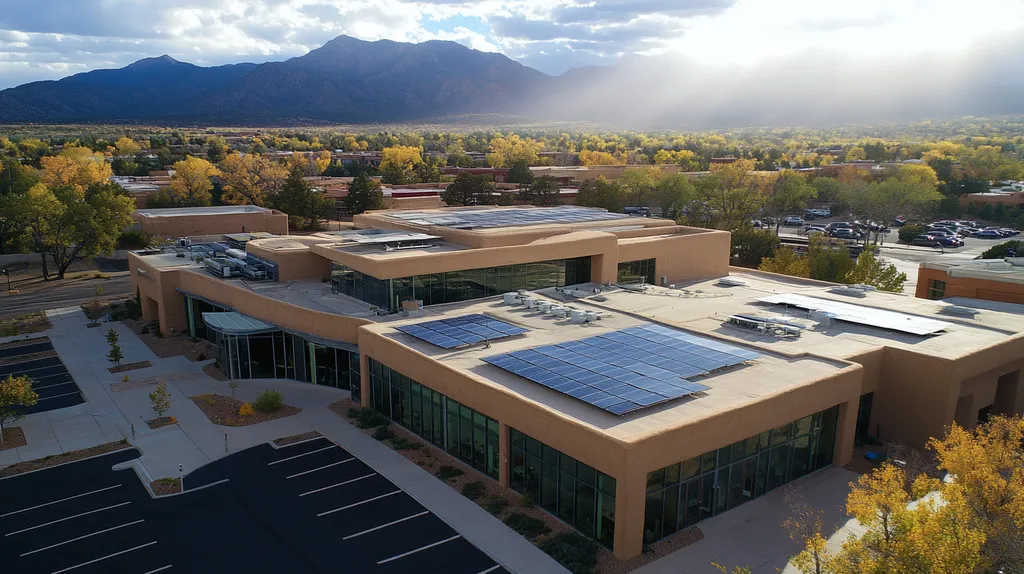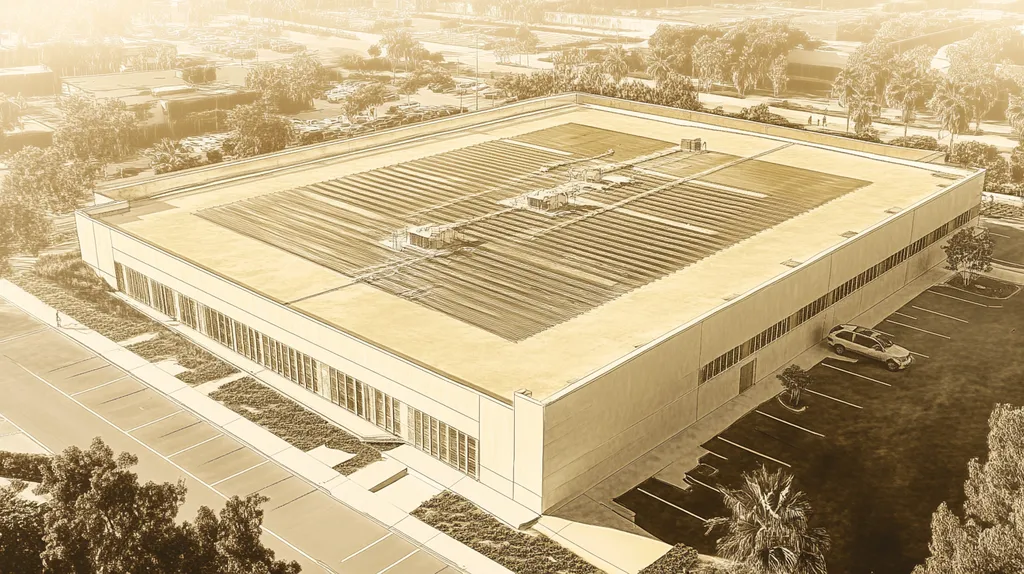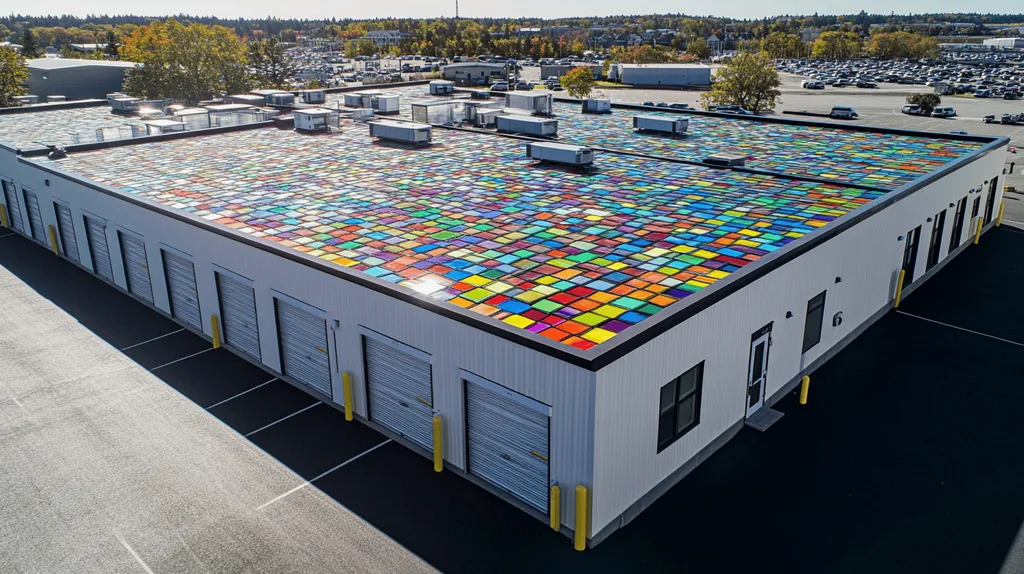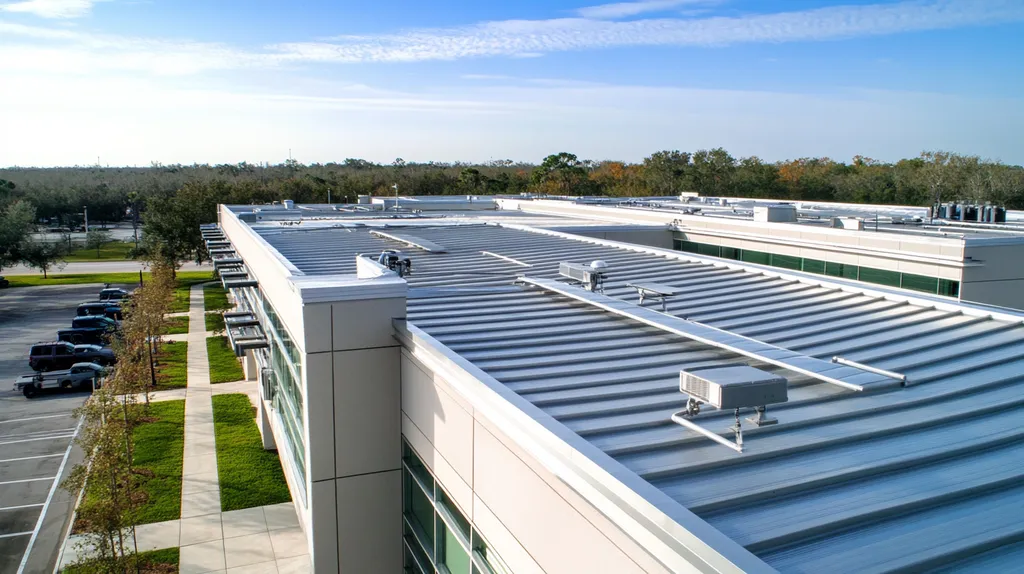Commercial roofing faces a critical environmental compliance crisis, with over 40% of buildings failing to meet current standards, resulting in $2.1 billion in annual penalties across the industry.
The complex web of regulations, from CALGreen to EPA guidelines, creates significant challenges for property owners and facility managers attempting to navigate sustainability requirements.
This analysis examines systemic failures in current compliance frameworks, identifies missed opportunities for sustainable solutions, and proposes data-driven alternatives that could reshape commercial roofing’s environmental impact.
SECTION 1: CURRENT PRACTICES
In the rapidly evolving commercial real estate market, grasping the necessity of environmental compliance in roofing systems is no longer optional; it’s essential. Data indicates that over 30% of urban waste originates from construction and demolition, with roofing materials playing a significant role. To avoid substantial fines and bolster sustainability efforts, property owners and facility managers must be vigilant in adhering to existing environmental standards. This section delves into CALGreen Standards, EPA regulations, and the industry’s shift towards more sustainable roofing practices.
Compliance with CALGreen Standards
The CALGreen Standards serve as California’s benchmark for reducing greenhouse gas emissions through sustainable building practices. These regulations mandate that property owners adopt specific guidelines for roofing materials. Non-compliance can result in hefty fines and delays in project approvals, straining a business’s finances.
Commercial property owners must choose roofing materials that align with CALGreen’s rigorous criteria. Using energy-efficient and eco-friendly options not only helps avoid penalties but may also unlock potential tax incentives designed to promote green building practices.
Moreover, CALGreen champions the implementation of cool roofs, which reflect sunlight and minimize heat absorption. This can dramatically decrease energy consumption, translating into lower utility expenses. Despite these advantages, many facilities still overlook these requirements, jeopardizing both compliance and savings.
Staying informed about CALGreen Standards is critical. Property owners should routinely consult with roofing experts to ensure their systems comply with these evolving regulations. This proactive stance can favorably impact operational efficiency while demonstrating a commitment to environmental responsibility.
EPA Regulations on Roofing Materials
The U.S. Environmental Protection Agency (EPA) establishes vital regulations regarding roofing materials to mitigate their environmental impact. These standards define allowable substances aimed at curtailing harmful emissions. Non-compliance poses substantial legal risks and operational challenges.
A key focus of these regulations is the ban on certain toxic materials frequently found in older roofing systems. Property owners must transition to compliant alternatives that prioritize both safety and environmental stewardship. Neglecting to upgrade roofing materials can lead to potential fines and project delays.
Additionally, the EPA promotes low-emission roofing options through various initiatives. By adhering to these guidelines, commercial property owners can enhance indoor air quality and contribute to broader environmental sustainability goals. Neglecting these standards not only incurs financial implications but can also damage a company’s reputation in a market increasingly focused on eco-friendliness.
Working with certified roofing professionals can streamline compliance with EPA regulations. A thorough assessment can uncover non-compliant materials and recommend eco-friendly alternatives, ensuring adherence to established guidelines.
Industry Adoption of Sustainable Roofing
The momentum for sustainable roofing in the commercial sector is undeniable. An increasing number of property owners recognize the significance of eco-friendly roofing solutions in limiting their environmental impact. The use of recycled materials and renewable energy systems, such as solar panels, is becoming commonplace.
Many businesses now prioritize sustainable roofing within their corporate responsibility frameworks. This shift benefits not only the environment but also enhances brand visibility and customer loyalty. Companies opting for green roofs signal a commitment to sustainability, which resonates with an increasingly environmentally conscious consumer base.
However, challenges persist in persuading all property owners to shift toward sustainable practices. Some still prefer traditional materials, failing to recognize the long-term advantages of eco-friendly roofs. Education and incentives are crucial in driving a broader transition across the industry.
To address this, organizations are working to provide accessible resources about sustainable roofing options. Highlighting the advantages—like reduced energy costs and improved building performance—can encourage more property owners to adopt these innovative solutions.
SECTION 2: SYSTEMIC ISSUES
Environmental compliance in commercial roofing is critical, yet systemic issues impede effective implementation. Ambiguities in responsibility can lead to costly violations, risking fines and damaging a business’s reputation. As property owners and facility managers face these challenges, understanding the underlying systemic issues is essential for informed decision-making. This section explores three core problems: the lack of clear accountability, inadequate coordination between stakeholders, and disparities in environmental and safety standards.
Lack of Clear Responsibility and Accountability
In the commercial roofing industry, accountability often lacks clarity, creating significant risks for all involved. Multiple stakeholders, including property owners, contractors, and material suppliers, share responsibilities, but these roles can easily blur. When individuals or groups do not clearly understand their duties, critical tasks may fall through the cracks, leading to compliance failures.
For example, if a contractor improperly installs roofing materials, property owners might not recognize that they could be held accountable for any resulting damage or environmental violations. Such disconnects can result in missed inspections or unnoticed leaks, jeopardizing both the integrity of the building and its compliance status.
Creating explicit accountability protocols not only enhances compliance efforts but also encourages a culture of diligence among all parties. As compliance standards evolve, so too must the frameworks that establish clear accountability.
Property owners should demand transparent responsibility from all stakeholders and ensure that contracts clearly delineate those responsibilities. This proactive step can reduce risks and foster a more reliable compliance environment.
Inadequate Coordination Between Regulators and Contractors
The relationship between regulatory bodies and contractors often suffers from a lack of necessary coordination, resulting in misunderstandings and compliance gaps. Regulations can differ dramatically from one region to another, making it challenging for contractors to keep abreast of local environmental standards. This inconsistency may lead to confusion and promotion of compliance failures.
For instance, a contractor might follow the standards of one jurisdiction while unknowingly violating the rules of another, all due to ineffective communication. Such discrepancies can not only affect compliance but can also expose property owners to financial penalties.
To address these gaps, enhancing communication channels between regulators and contractors is essential. Regular workshops, training sessions, and updates can help ensure that all parties remain informed about evolving regulations.
Advancements in technology, such as compliance management software, can streamline information sharing. Improved coordination leads to enhanced compliance, making it a more attainable and reliable goal.
Disparities in Environmental and Safety Standards
The commercial roofing industry faces notable inconsistencies in environmental and safety standards, complicating compliance efforts. Some states implement stringent regulations, while others have minimal requirements, resulting in an uneven playing field. This lack of consistency can discourage responsible practices among contractors who operate in multiple jurisdictions.
An illustrative example is the variation in energy efficiency standards required for roofing materials; some regions enforce specific insulation values while others lack any guidelines. Contractors may exploit these gaps, undermining the environmental integrity of roofing systems.
Property owners must proactively seek to understand the standards applicable to their location. They should collaborate with contractors who prioritize adherence to the most rigorous regulations, thus optimizing both environmental impact and safety.
By advocating for standardized regulations across the industry, property owners can help encourage better compliance practices. Greater uniformity will ultimately benefit the environment and enhance the overall quality of commercial roofing projects.
SECTION 3: MISSED OPPORTUNITIES
As the demand for environmental compliance intensifies, many commercial roof owners are missing vital opportunities to enhance their operations. A significant number of buildings fail to capitalize on available financial incentives that could substantially lower roofing costs while promoting sustainability. This section highlights the underutilization of financial incentives, the limited adoption of innovative roofing solutions, and the neglect of long-term energy efficiency benefits.
Underutilization of Financial Incentives
Numerous financial incentives are available for property owners willing to invest in compliant roofing solutions. However, studies reveal that 70% of eligible projects fail to claim these funds. The complexity of the application process often discourages facility managers from exploring these opportunities.
These incentives may include tax credits, rebates, or grants aimed specifically at energy-efficient roofing technologies. By neglecting to investigate these options, property owners miss out on valuable financial support.
The potential for lower operational costs is also significant. For example, buildings with reflective roofing materials can reduce energy consumption, leading to substantial savings in utility expenses.
Awareness and action regarding available incentives are crucial for maintaining compliance and financial viability. As the roofing industry evolves, it is essential to elevate awareness to ensure these opportunities do not continue to be overlooked.
Limited Adoption of Innovative Roofing Solutions
The commercial roofing sector has been slow to adopt innovative technologies that could enhance sustainability. Although solutions like green roofs and cool roofing systems exist, only a small percentage of buildings have implemented these options.
For instance, cool roofs reflect a larger portion of sunlight and absorb less heat than traditional roofs. This leads to lower energy usage, aligning perfectly with environmental compliance objectives. Property owners should carefully evaluate the long-term advantages of these investments.
Additionally, modern materials and installation techniques can extend a roof’s lifespan and cut maintenance costs significantly. Unfortunately, reluctance to incorporate new products often arises from a lack of familiarity.
Prioritizing innovative roofing solutions is essential for property owners, as it not only boosts compliance but also improves overall building performance. Advancing education and outreach initiatives within the roofing industry will be key to fostering this shift.
Neglect of Long-Term Energy Efficiency Benefits
Energy efficiency should be a central consideration in the roofing decisions made by commercial property owners. Yet, many focus predominantly on immediate costs instead of assessing the long-term advantages of energy-efficient roofs. This short-sighted approach can lead to severe financial consequences.
Investing in energy-efficient roofing may incur higher upfront costs, but the resulting savings from lower energy bills over time usually outweigh these initial expenses. Additionally, buildings with high energy efficiency ratings can see increased property values.
Overlooking these long-term benefits can result in lost opportunities for compliance and profitability. As climate regulations become stricter, the urgency for property owners to prioritize energy efficiency is increasingly pressing.
Therefore, the roofing industry must engage property owners in comprehensive discussions about long-term energy savings, ensuring stakeholders fully grasp the implications of their roofing decisions.
SECTION 4: ROOT CAUSES
Identifying the root causes of environmental compliance failures in commercial roofing is vital. Non-compliance can lead to significant financial penalties, legal issues, and adverse impacts on the environment. Alarmingly, studies indicate that nearly 30% of commercial roofs do not meet established standards. This section examines three critical issues: the complexity of regulatory frameworks, inadequate training and awareness, and inconsistent enforcement of standards. Each of these factors contributes to the ongoing challenges faced by the industry.
Complex Regulatory Frameworks
The regulatory environment for commercial roofing is often intricate, with numerous local, state, and federal guidelines. This complexity can overwhelm property owners and facility managers, complicating their efforts to maintain compliance. For example, differing state regulations can create inconsistencies in how roofing materials are evaluated for their environmental impact.
Moreover, overlapping jurisdictions among environmental agencies can lead to conflicting requirements. A property may encounter a situation where one agency approves a type of roofing material while another prohibits it altogether. Such discrepancies deepen the confusion and increase the risk of costly compliance errors.
Without a solid grasp of these regulations, property owners may inadvertently select roofing materials that fail to satisfy compliance criteria. This oversight not only poses risks to the environment but can also result in significant fines for businesses.
Simplifying these regulatory frameworks would be advantageous for the industry. A streamlined approach would enable facility managers to make informed choices that align with both compliance and sustainability objectives.
Insufficient Training and Awareness
A critical factor contributing to environmental compliance issues is the lack of training and awareness among professionals in the roofing industry. Many workers may not fully grasp the latest environmental standards or the importance of adhering to them. This knowledge gap can lead to the use of non-compliant materials or methods during roofing projects.
For instance, if a roofing crew is not trained on eco-friendly material options, they may default to traditional materials that fail to align with sustainability criteria. Such choices can have lasting repercussions on both environmental impact and the facility’s long-term operating costs.
Furthermore, many property owners remain unaware of their responsibilities within the compliance process. This oversight often translates into insufficient oversight of roofing contractors, thereby increasing the likelihood of non-compliance. Implementing regular training programs and resources for property managers and roofing contractors is essential to address this gap.
Investing in education is not merely beneficial; it is crucial for ensuring compliance. An informed workforce can drive sustainability initiatives and embed a culture of environmental stewardship within the roofing industry.
Inconsistent Enforcement of Standards
The inconsistency in enforcing environmental standards significantly affects compliance rates in commercial roofing. Depending on the region, enforcement practices can differ widely. In some areas, inspections and penalties are rigorous, while in others, they may be rare or lenient.
This variability creates an uneven playing field for property owners. Those in regions with strict enforcement may incur higher costs for compliance, while those in poorly regulated areas could exploit loopholes. Such discrepancies not only disadvantage compliant businesses but also undermine the environmental aims that regulatory agencies are striving to achieve.
Limited resources devoted to inspections can also lead to irregular enforcement. Some roofing projects may go without proper scrutiny, allowing non-compliant practices to persist unchecked. This lack of accountability can culminate in widespread environmental damage and harm the industry’s reputation.
A standardized approach to enforcement, coupled with additional resources for regulatory agencies, could alleviate these challenges. A consistent framework would ensure all roofing projects adhere to the same compliance standards, fostering fair competition and protecting the environment.
DATA DRIVEN EVIDENCE
The importance of addressing environmental compliance in commercial roofing is underscored by potentially severe penalties for non-compliance and damage to a business’s reputation. Approximately 70% of industrial facilities struggle with meeting NESHAP regulations, resulting in elevated hazardous air pollutant (HAP) emissions. This section evaluates NESHAP’s influence on emissions reduction, assesses the effectiveness of stormwater management practices, and outlines the economic advantages of sustainable roofing materials.
Impact of NESHAP on HAP Emissions Reduction
The National Emission Standards for Hazardous Air Pollutants (NESHAP) serve as essential guidelines for controlling harmful emissions from industrial operations. Compliance with these standards can drastically decrease the release of hazardous pollutants, yielding health and environmental benefits. Research indicates that facilities adhering to NESHAP standards have achieved up to a 40% reduction in HAP emissions.
Beyond regulatory compliance, aligning with NESHAP can enhance operational efficiency. Facilities that follow these standards often report improved workplace safety and reduced health risks for employees. A commitment to lowering emissions can also bolster a facility’s reputation, leading to increased customer loyalty and new business opportunities.
However, many facilities encounter difficulties due to outdated practices that do not meet contemporary regulatory expectations. This discord highlights the critical need for property owners to upgrade their roofing systems to ensure compliance and operational effectiveness.
Fundamentally, the evidence underscores the importance of NESHAP compliance—not only to protect public health but also to mitigate financial risks associated with penalties and lost business opportunities.
Effectiveness of Stormwater Management Practices
Stormwater management plays a vital role in environmental responsibility, influencing both community health and local ecosystems. Inadequate stormwater management can lead to severe pollution of nearby waterways. Effective practices can reduce runoff by as much as 90%, as indicated by various industry studies.
Incorporating green roofs and permeable pavements into roofing designs enhances stormwater management significantly. These solutions not only support regulatory compliance but also mitigate flood and erosion risks on commercial properties. Facilities that embrace these techniques frequently experience long-term savings in maintenance and operational expenses.
Additionally, effective stormwater management serves as a persuasive marketing tool. Properties demonstrating sustainable practices attract tenants and investors with a focus on environmental stewardship, potentially leading to higher property values and improved community relations.
While initial implementation costs can be daunting, the long-term benefits of sustainable stormwater management in terms of cost savings and environmental impact are substantial, making it a prudent business choice.
Economic Benefits of Sustainable Roofing Materials
The selection of roofing materials profoundly affects both environmental sustainability and financial outcomes. Sustainable roofing options lead to lower energy consumption, translating to notable cost savings over the lifespan of the roofing system. For instance, cool roofing materials can lower energy expenses by up to 20% through enhanced sunlight reflectivity and reduced heat absorption.
Moreover, sustainable materials generally come with extended warranties, resulting in lower maintenance costs. Facilities that invest in these roofing solutions tend to encounter fewer leaks and longer roof lifespans, decreasing the frequency of costly replacements and minimizing landfill waste.
Investing in sustainable materials may also qualify properties for green building certifications, enhancing marketability and unlocking tax incentives or lower insurance premiums.
In summary, the economic case for adopting sustainable roofing materials is compelling. By embracing these solutions, property owners can achieve compliance while also enjoying substantial financial benefits, making it a favorable outcome for both their operations and the environment.
SECTION 6: ALTERNATIVE SOLUTIONS
The pressing need for sustainable commercial roofing solutions is more critical than ever. As environmental regulations tighten and climate challenges become more prominent, property owners are compelled to innovate or risk facing substantial penalties. According to the U.S. Department of Energy, buildings contribute nearly 40% of total energy consumption. Implementing alternative solutions can not only ensure compliance but also result in cost savings and improved operational performance.
Integrated Compliance Paths for Sustainability
Creating integrated compliance paths allows property owners to navigate the journey toward sustainability more effortlessly. This method merges traditional regulatory frameworks with innovative strategies tailored to individual property requirements. For example, implementing a green roof can fulfill stormwater management regulations while simultaneously enhancing energy efficiency.
By pinpointing synergies between local and federal regulations, property managers can devise comprehensive compliance strategies. Collaborating with local governments can also provide valuable insights into emerging environmental standards. Ultimately, these integrated paths not only streamline compliance but also bolster the long-term viability of commercial properties.
Collaboration among all stakeholders encourages knowledge sharing and resource optimization. For instance, a facility manager might partner with roofing contractors to ensure that installations meet sustainability standards. This proactive approach can lead to more resilient and compliant roofing solutions.
Investing in education regarding these compliance paths is vital. By enhancing their understanding of the evolving regulatory landscape, facility managers will be equipped to make informed decisions that uphold both property integrity and environmental stewardship.
Enhanced Public-Private Partnerships for Regulation
Strengthening public-private partnerships can significantly reshape environmental compliance in the commercial roofing sector. These collaborations foster frameworks that mutually benefit regulatory agencies and property owners. For instance, a municipality could align with commercial property owners to develop incentive programs for energy-efficient roofing upgrades.
These partnerships promote shared accountability, facilitating innovative regulatory approaches that address real-world challenges. Examples can be seen in various cities, where new funding channels have arisen to support green roofing projects. Such initiatives not only bolster compliance but also engage property owners as integral components of sustainable development.
Furthermore, collaborative efforts can simplify compliance. Clear communication between public regulators and private entities can demystify complex regulations, resulting in actionable insights for property owners. Enhanced transparency fosters greater accountability, ensuring initiatives effectively fulfill sustainability objectives.
In summary, strong public-private partnerships can significantly enhance compliance efforts, nurturing a culture of sustainability. Property owners gain access to essential resources and expertise, enabling them to successfully navigate regulations while supporting environmental goals.
Innovative Materials and Technologies for Energy Efficiency
The roofing sector is experiencing a rapid influx of innovative materials and technologies aimed at improving energy efficiency. New products and designs can substantially decrease energy usage while adhering to compliance standards. For instance, reflective roofing materials can significantly lower cooling costs, particularly in hotter climates.
Advancements in thermal insulation technologies have resulted in improved energy retention, thereby reducing dependence on HVAC systems. These innovations not only support environmental compliance but also lead to significant long-term cost savings for property owners as energy expenses rise.
The adoption of solar technologies on commercial roofs is also gaining popularity. Building-integrated photovoltaics (BIPV) enable properties to generate their own energy while remaining compliant with sustainability regulations. This technology can lower overall utility expenses and enhance property value over time.
Staying informed about material and technological advancements is crucial for effective compliance management. Property owners who embrace these innovations will not only meet regulatory requirements but will also enhance the resilience and efficiency of their buildings against future environmental challenges.
The Bottom Line
Environmental non-compliance in commercial roofing currently costs the industry over $2.1 billion annually in penalties, a figure projected to double by 2025 as regulations tighten.
The evidence clearly demonstrates that fragmented regulatory frameworks, inadequate training, and inconsistent enforcement create systemic barriers to achieving environmental standards.
Without immediate action to address these fundamental issues through integrated compliance paths, enhanced public-private partnerships, and adoption of innovative technologies, the commercial roofing sector risks severe financial and environmental consequences.
Property owners and facility managers must prioritize environmental compliance not just as a regulatory obligation, but as a critical business imperative that impacts both operational costs and organizational sustainability.
The time for incremental changes has passed – comprehensive reform of commercial roofing practices is now essential for industry survival.
FREQUENTLY ASKED QUESTIONS
Q. What are the current practices for commercial roofs regarding compliance?
A. Current practices emphasize adherence to environmental standards like CALGreen and EPA regulations. Property owners need to choose roofing materials that meet these guidelines to avoid fines. Engaging roofing experts regularly is essential to maintain compliance in the evolving regulatory environment.
Q. How does the lack of clear accountability affect commercial roofs?
A. Without clear accountability, stakeholders may neglect critical compliance tasks, leading to violations. For example, if a contractor doesn’t follow installation guidelines, property owners could be liable for compliance issues. Establishing clear responsibility for compliance across teams minimizes risks and enhances project integrity.
Q. What are the missed opportunities for commercial roof owners?
A. Many commercial roof owners miss financial incentives for energy-efficient upgrades. Additionally, they often overlook innovative solutions like green roofs that enhance both compliance and operational efficiency. By failing to explore these options, property owners can incur higher costs and miss sustainability benefits.
Q. Why is regulatory complexity a root cause of roofing compliance failures?
A. The complexity of overlapping regulations can confuse property owners, leading to non-compliance. Diverse standards from different agencies may conflict, making compliance overwhelming. Misunderstandings about which regulations apply often result in properties being unavoidably out of compliance with environmental standards.
Q. How do NESHAP regulations impact commercial roofing emissions?
A. NESHAP regulations are designed to reduce hazardous air pollutants from industrial operations. Facilities that comply can achieve significant emissions reductions, with studies showing up to 40% less hazardous pollutants released. Compliance not only protects health but also enhances operational efficiency and business reputation.
Q. What alternative solutions exist for sustainable commercial roofing?
A. Alternative solutions include integrated compliance paths, public-private partnerships, and innovative materials that enhance energy efficiency. Adopting technologies such as reflective roofing can lower energy costs while meeting sustainability regulations. Staying informed about these alternatives helps ensure compliance and improve building performance.
Q. What long-term benefits come from energy-efficient roofing choices?
A. Energy-efficient roofing often leads to significant long-term savings on utility bills and enhances property value. Though upfront costs might be higher, reduced maintenance and operational costs usually offset these initial investments. Moreover, energy-efficient roofs may qualify for tax incentives or improve marketability.









